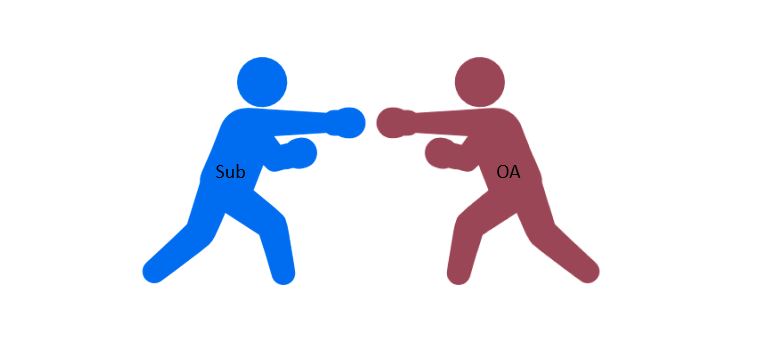Tying all of the revenue associated with and costs of publication to the researcher creates an inherent conflict of interest.
The STEM publishing industry has undergone at least 2 paradigm shifts since I entered the industry. In 2000, when I started at the American Association for the Advancement of Science (AAAS), a not-for-profit society publisher, print journals with individual subscriptions for many titles were common with additional titles available in libraries. If you needed a personal copy, you had to pay for a photocopy. So, even though the library provided access, it did not provide personal copies. The print journals sold advertising, had individual and institutional subscribers, and authors paid fees for article or figure processing or page charges. The journals with high circulation had high advertising revenue. Then, many journals began putting their content online, individual subscriptions dropped, print advertising revenue precipitously declined, and institutional subscriptions became the primary revenue stream and access model. This switch from primarily or only print access to online access with or without print and the associated change from individual subscriptions to institutional licenses were the first shifts that I experienced.

The second shift is ongoing and relates to the open access (OA) business model. Just to be clear, this is a business model. OA is not about ethics and morality; it is a business model in scholarly publishing. With the announcement that research funded by public grants in Europe will be required to be published in fully OA journals by 2020 (https://www.scienceeurope.org/coalition-s/), I wonder if the implications of this edict are understood.
In the subscription model, the reader or the reader’s library pays for the finished product, the article in or issue of the journal. Value is assessed after publication. If the value is not high enough, the journal does not have enough subscribers to cover costs and will eventually go out of business. Alternatively, titles with low subscriptions or readership can be continued if the publisher has other titles that support the lower value ones in the portfolio. The primary customer is the reader or the reader’s institution, not the author. The authors only contribute a small part of the publishing costs. Most of the cost of and revenue generated by the journal is covered after publication by subscriptions. The risk is that the quality will be insufficient to warrant the post-publication subscription costs. The customer is separate and not associated with the author. This model fosters high selectivity and enables low volume journals to survive. Revenue is not directly proportional to the number of articles published.
In the OA model, value is assessed prior to publication in the form of article processing charges (APCs). In this model, the risk is that the journal will not have sufficient submissions to cover the costs of publication. The customer is tied to the author: It is either the author, the author’s funding agency, or the author’s institution. Revenue is directly coupled to the number of articles published. For OA to be highly selective, either the costs for publication have to be very high, costs have to be highly subsidized, or some titles in the portfolio have to provide sufficient revenue that other titles can be more selective or have very low volume of content.
An example of a subsidized system is PeerJ. In addition to APCs, PeerJ offers memberships. Institutions can become “members” of PeerJ and thereby reduce the APCs charged to authors who are scientists at member institution. Authors can also become members, paying an increasing fee for an increasing number of articles published per annual membership. The catch with the membership option is that all authors have to have a membership. It can be less expensive for an article with many authors who are not members to pay the APC. The membership system provides a basis of income for PeerJ independent from how many articles are published.
As an example of a portfolio with a revenue-generating title, consider PLOS. PLOS One has published 205,926 articles since its launch in December 2006. That equates to ~18,700 articles published per year. At $1595 per article, this can bring in a substantial amount of revenue. Even limiting the articles to those with “Materials and Methods” shows a large difference between the articles published in PLOS ONE (198,150) and those in the more selective titles, PLOS Biology (3580) or PLOS Medicine (2,605). Furthermore, PLOS Biology was launched in October 2003, so had 3 years longer to accumulate articles than did PLOS ONE. Indeed, using the “Materials and Methods” search, PLOS ONE has published 6.3 times the number of articles than all other titles in the portfolio. Another way that the more selective titles maintain a level of competitiveness is by having higher publication fees than the less selective titles in the portfolio. Here again, PLOS is representative.
The argument in favor of OA publishing is that the research has already been funded, often by tax payers, so the product should be freely available. The research may have been funded, but the process of publication has not. Selection of research worthy of becoming part of the published literature has not been funded by the funding of the research itself. Indeed, the results of many experiments will never be published. There are many reasons results are not published. Just a few examples include they simply don’t represent new findings, the experiments were flawed, or results were not reproducible. In addition to the primary role of gatekeeper that the publisher plays in the scientific endeavor, publishers also provide article compilation, copyediting, proofreading, archiving, indexing, delivery of content to third-party services.
Another argument is that academic publishing is inexpensive, because the process is done by volunteers. The process is not inexpensive, regardless of whether there are volunteer academic editors and volunteer reviewers. This argument fails to account for the cost equation of the support staff — the publication or editorial assistants who track and assign manuscripts to the appropriate editors — the production staff who manage or perform the copyediting, proofreading, and compilation process, the digital media staff who work with the hosting service to ensure that the content is delivered and appears online on schedule, the staff who manage permissions and handle legal issues, and finally the publisher’s management that oversees the entire process. In addition to staff, publishers require manuscript tracking systems for managing article submission and review and author correspondence. Even a journal without professional editors has substantial costs.
For a publisher that strives to provide selective, rigorously reviewed, highly visible content, there are often parts of the journal that do not generate APCs and so would not contribute financially to the OA business model. Such content may be news articles, commentaries, reviews, or policy forums. News content, in particular, is quite expensive requiring staff writers and reporters or the use of freelance writers. Using freelance writers requires having infrastructure and staff to track their contributions and payments. Commentary and review articles are often associated with striking visuals, which frequently require having staff illustrators or working with freelance artists. Finally, journal and content marketing requires staff and financial resources.
The idea that the publisher functions only as a conduit to provide the reader access to the research is simply misguided. Through the selection and review process, publishers properly serve as gatekeepers to the literature. The explosion in predatory publishers since the OA movement illustrates what happens when this gatekeeper function is missing. The publishing process provides and adds value. The process is not inexpensive. Properly done, the process of article publication takes research findings, ensures that they meet the requirements for inclusion in the scientific record, wraps the findings into a story and package that is available, readable, and understandable (at least for the experts in the field). Tying all of the revenue associated with and costs of publication to the researcher creates an inherent conflict of interest. The journal needs the content to stay viable, and the author needs the publications to stay employed and funded. Both have a conflict in achieving that goal without compromising the integrity of the process.
To put it in simple terms, if a journal needs to publish 100 articles to obtain enough APCs to cover costs:
How much pressure will there be to publish 100 articles even if out of the submissions only 80 really met the criteria?
How much pressure will there be to use reviewers likely to be less critical?
How selective can the process really be?
Do we really want a flat plane for the scholarly literature?
To keep some level of differential selectivity, will every publisher have to add a high-throughput title with low selectivity to support any highly selective titles?
Cite as: N. R. Gough, Business Model Wars in Scholarly Publishing. BioSerendipity (10 October 2018) https://www.bioserendipity.com/business-model-wars-in-scholarly-publishing/

